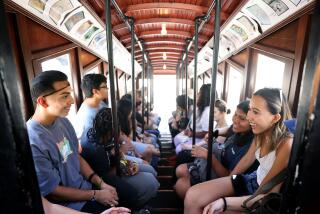Multiculturalism: Building Bridges or Burning Them? : Race relations: Educators rethink courses after worries that emphasizing ethnic pride increases divisiveness.
Multiculturalism--the notion that ethnic and cultural groups in the United States should preserve their identities instead of fusing them in a melting pot--has become a byword in education in Los Angeles and other cities.
But now, educators at the elementary, secondary and university levels are rethinking that idea--and worrying that past efforts to teach multiculturalism may have widened the ethnic divisions they were meant to close.
Fearing that the current approach--which relies largely on ethnic studies courses and the recognition of special holidays and heroes--may have unintentionally isolated students from each other, teachers and academics are gingerly beginning to question the way multiculturalism has been taught.
âI think many people, especially in the post-Rodney King era, are beginning to realize that we canât just study ourselves as separate groups,â said Ronald Takaki, ethnic studies professor at UC Berkeley. âWeâve gone beyond the need to recover identity and roots, and now weâre realizing that our paths as members of different groups are crisscrossing each other.â
Not that these educators have abandoned multiculturalism as a concept. Nor do they suggest schools are solely to blame for ethnic tensions in society and on campus. But, in growing numbers, they are struggling to better define multiculturalismâs goals and ways to teach it.
At present, many courses either focus entirely on one ethnic population or teach a standard history and throw a few ethnic names into the mix. The new approach would teach events as they had happened--as interconnected and inclusive history that changed lives in every ethnic group, and was also changed by all of those groups.
The discussion is so new that it has barely begun to show up in the pages of education journals. But it is gaining speed among teachers, administrators and university professors, many who were surprised to discover that others are voicing the same concerns.
Even students, searching for reasons why violence erupted recently at North Hollywood High School and other campuses in the Los Angeles Unified School District, suggested that some youngsters have misunderstood lessons about ethnic pride, developing ethnic chauvinism instead.
âThey teach you that you have to identify with your own group,â said Karina Escalante, a senior at Cleveland High School in Reseda, where African-American and Latino students clashed last year.
She said students receive conflicting messages that teach them pride in their ethnic identities but not how those identities can and should mesh with others in society. âThey tell you to keep with your own. Then they tell you to go out and mix. They should have a program that says: âYes, you should identify yourself but then you have to go out and mix.â â
Educators in the Los Angeles district say they are particularly troubled and point to the violence that broke out in October between African-American and Latino students at North Hollywood and Hamilton high schools.
Esther Taira, the resource teacher who in 1986 spearheaded the development of a multicultural curriculum for the districtâs high schools, said she would design her course very differently today.
âWe do have ethnic-specific courses, but they do not create the bridges we need,â said Taira, whose course is an elective offered only in some schools. âEven when we do talk about more than one group, we tend to focus on similarities, and that ignores the problems in the streets. It is the differences that are the issues.â
Among youngsters, feelings of isolation can start early.
In Christine Tolesonâs fifth-grade and Marcia Kleinâs sixth-grade classes at Pacoima Elementary School, where the walls are festooned with posters in English and Spanish, students said they felt happy and proud when the school celebrated holidays or held âappreciation daysâ for their ethnic group. Most students said they remembered discussing their heritage in class.
But very few students raised their hands when asked whether they remembered discussing the culture of a different ethnic group.
âOn Martin Luther King Day, they were celebrating black people,â said Gerardo Nunez, a Latino fifth-grader. âI went over there. Other people were not my color. I felt all alone.â
Originally, the term multiculturalism was used by minority activists in the mid-1980s who rejected assimilation. They believed that students should be taught about their ethnic and cultural backgrounds, which would bolster their pride and preserve their cultural identities.
Within that movement, two competing theories developed. One, called particularism, emphasized separate ethnic studies courses, such as Chicano studies or black studies. The other, pluralism, recommended that information about each group be woven into traditional courses.
By far, the particularists have dominated, bringing to campuses not only special ethnic studies courses but clubs, dormitories and celebrations that have ethnic themes.
For example, a typical class in a multicultural program would be âa course that an African-American student can take which gives him a sense of identity,â said Deborah Dash Moore, director of the American Culture program at Vassar College in Poughkeepsie, N.Y., and an organizer of a recent conference on ways to teach American studies. âIt gives him a cultural connection with others, respect for his past, and a sense of knowing where he fits within a larger society of which he can be proud.â
The new movement finds particularists and pluralists moving toward a middle ground, where instead of treating each ethnic group separately, elements from all their histories are woven into discussions of particular topics.
âIâm in the movement toward bringing them together,â said Los Angeles Board of Education member Warren Furutani, an advocate of ethnic studies who was formerly the program coordinator at UCLAâs Asian American Studies Center. âBecause it means people can understand their own experience, but bring it together with other peopleâs experiences.â
Raising questions about multiculturalism has been difficult for educators, in part because the movement has come under intense criticism from conservatives such as Dinesh DâSouza, of the American Enterprise Institute, whose book, âIlliberal Education: the Politics of Race and Sex on Campus,â reached the New York Times bestseller list.
âMany people are very defensive, and have been put on the defensive by attacks by conservatives,â Vassarâs Moore said. âThey feel that there is no room for them to be self-reflective, self-critical, that if they do some critical thinking they are playing into the hands of people who really want to destroy the entire enterprise.â
In the Los Angeles public schools, teachers at all levels are encouraged to talk about the different cultures represented by their students. Most schools conduct festivals or hold special assemblies or parties to celebrate such holidays as the birthday of Martin Luther King Jr. or Cinco de Mayo, which marks the day Mexico defeated French forces in the Battle of Puebla.
In addition, the district has developed for high schools elective ethnic studies classes--including African-American studies, Mexican-American studies and courses about Asian and Jewish concerns. From kindergarten on up, the reading and history curricula include stories and information about diverse cultures.
Cultural Awareness, the class developed by Taira, explores similarities between ethnic groups and discusses the contributions of a number of cultures.
But Taira said if she were designing that course today, she would take pains to interweave the lives and experiences of members of different ethnic groups. Sharing her concerns, Takaki, the UC Berkeley professor, said he wished he had made his 1989 book âStrangers from a Different Shoreâ--which chronicles Asian immigration to the United States--more inclusive.
In schools and at universities, they and others said, even courses that spotlight several ethnic groups tend to treat each group separately. A course might highlight African-Americans one week, Korean-Americans the next, and so on.
And, experts said, most students tend to take only the classes that relate to the group to which they belong. In Los Angeles, administrators said, many schools offer only those courses that relate to the majority of their student populations.
In such a climate, even the celebration of ethnic holidays has caused problems, with one group believing that another got more attention or boycotting another groupâs festivities, said Casey Browne, who heads the peer counseling program at North Hollywood High.
âTo some extent I think we bring on racial tensions when we celebrate one holiday over another,â Browne said. âSome schools do a better job on certain holidays than they do on others, and then the other kids feel left out.â
Such problems have developed, said Bernadine Lyles, the school districtâs multicultural education unit adviser, because âthe climate was not preparedâ for students to want to celebrate the cultures of others.
She noted that a framework for multicultural education adopted by the school board last spring emphasizes âactivities that would bring groups together, rather than those activities that might look like separation.â
In the new course that Taira is developing, lessons are organized around historical themes instead of ethnicity.
If the subject is American agriculture, Taira said, the teacher might discuss how farming and ranching affected the lives of black African slaves, Chinese and Mexican immigrants and poor whites who worked as sharecroppers--all within broader contexts such as family farms or the plantation economy of the South.
âThere has been a drawing back from the notion that we just have to add more African-Americans, or add more Latinos, as well as the notion that we have to focus on victims,â Moore said. âPeople are in a complex relationship with each other. They may be victims in one set of relationships and served in others.â
Students sum up the situation most poignantly--and appear to offer the most hope.
After last monthâs racial brawl at North Hollywood High, senior Pele Keith called out to a group of African-American and Latino students who were arguing about the events of that troubled day.
âThey say brown pride, but look, Iâm just as brown as she is,â Pele, an African-American, said, placing her arm alongside the arm of a Latino friend, Patti Martinez.
âLook at that,â Patti sang out in reply, âthe same color.â
More to Read
Sign up for Essential California
The most important California stories and recommendations in your inbox every morning.
You may occasionally receive promotional content from the Los Angeles Times.










